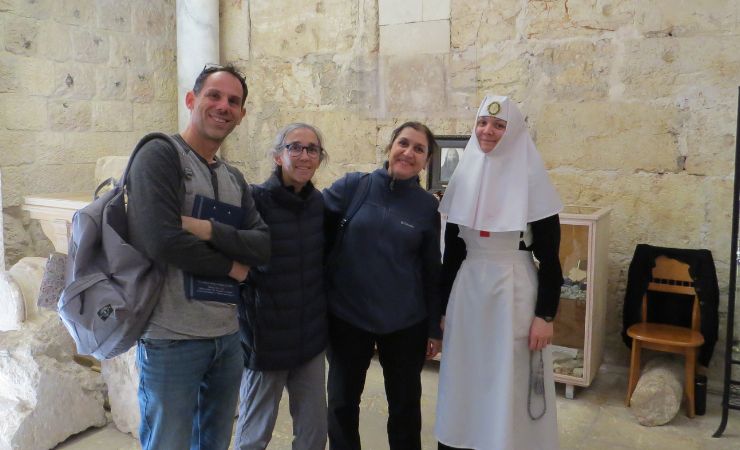Alexander Nevsky Church: The Church with a Roman Arch
The Alexander Nevsky Church, a Russian Orthodox marvel, is a testament to Jerusalem’s rich and diverse history. This architectural gem, built between 1896 and 1903, is named after the 13th-century Russian military leader, Alexander Nevsky, who expanded Russia’s borders and won the public’s admiration.

Credit Ian Scott, CC BY-SA 2.0, via Wikimedia Commons
Location
The Alexander Nevsky Church is situated in the Christian Quarter of the Old City of Jerusalem. It is located near the Church of the Holy Sepulchre.



Historical Context and Architecture
The Alexander Nevsky Church’s history dates back to the mid-19th century. The property where the church stands was purchased in 1857 by the “Imperial Orthodox Palestine Society,” with the initial intention of building a hostel and a consulate for the many Russian pilgrims visiting Jerusalem at the time.
The church was named after Alexander Nevsky, a 13th-century Russian warrior-prince known for his victories against German and Swedish invaders. However, during the excavation conducted prior to the construction in 1883, significant archaeological remains were discovered, leading to a change in plans. The findings were so significant that the intended consulate and hostel were built outside the city walls at a site known today as “The Russian Compound,” while the Alexander Nevsky site was designated as a church, although it serves more as an archaeological and relics exhibit.
At the entrance to the church, the symbol of the Imperial Orthodox Palestine Society is displayed on top of the building. This is the institution that established the Russian institutions during the Ottoman era. This symbol contains the Greek letters Xi and Ro, the initials of the word “Xristos”, which means messiah in Greek. The society’s flag waves on top of the building alongside the Russian flag, symbolizing the church’s historical ties to Russia.
The grand entry into the church, which resembles a hotel’s entryway, leads to a Baroque-style interior. Inside, there is a royal hospitality room, a hall where many icons and various relics are on display, and walls adorned with several large neo-classical style paintings depicting scenes of the Passion of Christ1..

Archaeological Findings at the Alexander Nevsky Church
The construction of the Alexander Nevsky Church led to the unearthing of several significant archaeological findings that provide a window into Jerusalem’s past.
As you venture deeper into the church, a “victory arch” built during the time of Emperor Hadrian is seen. This arch is one of four constructed in Jerusalem by the Hadrian, with the famous Ecce Homo Arch at the beginning of the Via Dolorosa being another.
Under your feet you will discover the remnants of a Roman forum built during the second century AD.
One of the most important discoveries of the excavations that took place in this church is the remains of massive walls from the time of King Herod, and an opening between them. Given the church’s proximity to Calvary (the Golgotha in Greek, or Calvary in Latin), it had been argued that this was the Threshold of Judgment Gate, which marked the edge of the city walls in the time of Christ.
You will be able to see a hole made in the wall for the stakes of the gate’s doors – this hole is referred to as the “Eye of Needle”. Anyone who manages to pass through this hole will have a place in heaven.
One of the highlights of this church is a column that was part of the main entrance to the basilica of the Holy Sepulchre built by Constantine the Great in 330 AD. In Roman times, the main entrance to the basilica was part of the Roman Cardo Maximus. The column is unique as it is made of black stone, which is not available in the vicinity of Jerusalem. Because of this, archeologists concluded that this stone was brought from a distance to mark an important place. Today we can see remains of these columns, like the one at station number 7 of the Via Dolorosa, and others at the excavation site of the Cardo in the Jewish quarter.
In front of us is a Crucifix fixed on a large stone from Calvary. Below it, enclosed by a wooden frame and covered with glass, is a stone of an ancient road on which Jesus may have walked as he exited the city walls to his crucifixion at Calvary.
Sources and Additional Reading
Alexander Nevsky Church in Jerusalem | Danny The Digger
Alexander Nevsky Church Jerusalem Video | Jerusalem Experience”
Nearby Sites
- Church of the Redeemer: Just around the corner from the Alexander Nevsky Church, this Lutheran church offers a stunning view of Jerusalem from its bell tower.
- Via Dolorosa: This path, marked by 14 Stations of the Cross, is believed to be the route Jesus took on his way to crucifixion.
- Church of the Flagellation: Located near the start of the Via Dolorosa, this Roman Catholic church commemorates the spot where Jesus Christ was flogged by Roman soldiers before his journey carrying the cross.
- Moristan: This is a complex of streets and shops in the Christian Quarter of Jerusalem. It was the location of the first hospital of the Knights Hospitaller.
- Jaffa Gate: One of the seven main open gates in Jerusalem’s Old City Walls.



